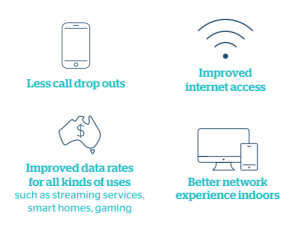What are small cells?
Small cells provide additional network capacity or mobile device coverage to a small geographic area. They operate at lower power than a traditional mobile phone base station and use smaller equipment.
Small cells complement existing technology and work with existing sites to provide a better network experience. Small cells can be deployed with minimal visual impact as they use smaller antennas, smaller equipment and can be co-located on existing infrastructure such as electricity and light poles. Small cells can be used to either increase the existing network capacity or provide new coverage. Small cells are built in all areas including urban and rural communities and are suitable for sensitive locations such as residential areas.
How will I benefit?
Small cells can improve network coverage indoors and at street level. This means your service may have:

How are small cell sites chosen?
Most small cells will be placed on existing infrastructure such as utility poles and street furniture. They are located in places where people live, work and play so that we can get things done when and where we need to.
There are many factors that are considered when choosing the location for small cells:
- Network coverage requirements for the area
- Proximity to existing sites and planned new sites
- Existing infrastructure that can be used
- The height of available structures
- Free space and capacity of the structure
- Topography and the surrounding environment
Are small cells safe to be near houses?
Yes. All mobile phone base stations, including small cells, must operate within safety limits set by the Australian Radiation Protection and Nuclear Safety Agency (ARPANSA). These limits protect the community, including children and the elderly, 24 hours a day.
The environmental electromagnetic energy (EME) levels from small cells are reported in an ARPANSA environmental report, and are available Radio Frequency National Site Archive (RFNSA) website.
Do small cells require local government approval?
Mobile phone carriers are required to consult with Councils, and consider their feedback. Generally small cells are installed using the Commonwealth Telecommunications (Low-impact Facilities) Determination 2018; therefore local government approval is generally not required.
How are residents notified?
The Mobile Phone Base Station Deployment Code requires Carriers to notify Council, residents and key stakeholders in the immediate vicinity of a proposed small cell location. Interested and affected parties will be invited to provide comments on the proposal. You can find out information on a small cell proposal by searching the location on the RFNSA website
For more information have a look at our fact sheets

